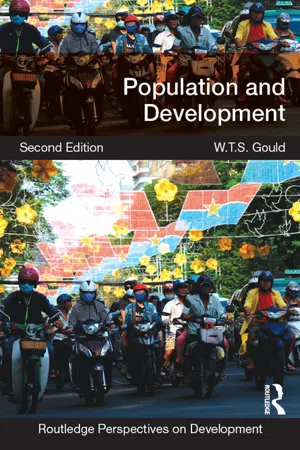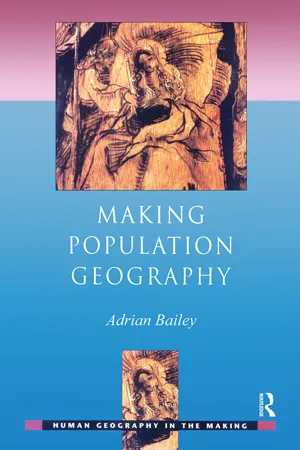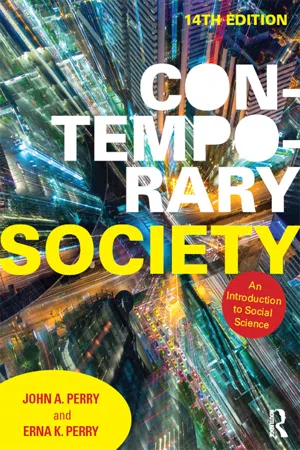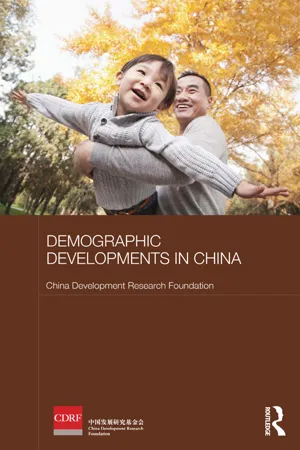Geography
Population and Development
Population and development refer to the relationship between the size, distribution, and characteristics of a population and the social, economic, and environmental changes that occur as a result. This includes studying how population growth, urbanization, and migration impact a region's development, including its infrastructure, resources, and quality of life. Understanding this relationship is crucial for planning and policy-making.
Written by Perlego with AI-assistance
Related key terms
7 Key excerpts on "Population and Development"
- eBook - ePub
- W.T.S. Gould(Author)
- 2015(Publication Date)
- Routledge(Publisher)
1 Population and Development: the core issues in historical perspectiveThis chapter provides:introduction to the language and basic ideas of Population Studies and of Development Studies, and the relationships between them;global review of how and why have population growth and development been linked in the past, and especially in the last 250 years of rising rates of world population growth and rapid development;region-specific discussions of population growth and development relationships for the major continental regions of the world;an identification of the wide range of circumstances in which population/development relationships have been worked out.At its core the relationship between Population and Development is primarily, though not exclusively, an economic one. It is about the aggregate consumption and production of resources, and the balance between consumption and production. Populations consume ‘resources’. These may be food or energy or other naturally occurring resources, as well as other ‘resources’, such as the cultural resources created by societies and/or provided by the government, such as schools or hospitals or roads. The economy concerns the production of all these resources. The essence of ‘development’ has been that this resource base has been consistently expanding. Globally, there is now more food and energy being produced than ever before. More people are attending schools or have access to medical care than ever before. However, the population has also been growing. The more people there are, the greater the resource base needs to be if average consumption levels are to be sustained. Per capita production (the average amount of any resource available per person in the population), and not merely gross production, needs to be sustained where there is population growth. - eBook - ePub
An Introduction to Population Geographies
Lives Across Space
- Holly R. Barcus, Keith Halfacree(Authors)
- 2017(Publication Date)
- Routledge(Publisher)
There is a clear prima facie case for the discipline of Demography : “the scientific study of the size, composition, and distribution of human populations and their changes resulting from fertility, mortality, and migration” (Poston and Bouvier 2010: 3). Births, deaths and human migrations between locations across the globe certainly require measurement, presentation and discussion, and future trends predicted. But whilst Demography also involves itself with the causes of the patterns, trends and magnitudes it identifies—“the factors that affect these components” (Poston and Bouvier 2010: 3)—a more dedicated emphasis on their contextualized spatial expression has become the focus of Population Geography. 1.2.2 … across real places Population Geography can be defined initially as the study of “the geographical organization of population and how and why this matters to society” (Bailey 2005: 1). An immediate illustration of how such a spatial lens is both significant and important comes, once again, via some simple demographic facts about the state of the world today (developed more fully in Chapter 3). Consider infant mortality rates (10.3.1) in a small selection of countries in Asia and Europe, shown in Table 1.1. First, even across these ten countries there is a considerable range of values. This is true even within the same continent, such as the contrast between Romania and Norway in Europe. Second, although there is a general trend towards declining infant mortality, countries such as Mongolia and India retain extremely high rates. Furthermore, many countries affected by civil strife, such as Afghanistan, Congo or Iraq, are understandably unable to provide data. Thus, Table 1.1 is biased in favor of countries experiencing relative political stability - eBook - ePub
Demographics
A Guide to Methods and Data Sources for Media, Business, and Government
- Steven H. Murdock, Chris Kelley, Jeffrey L. Jordan, Beverly Pecotte, Alvin Luedke(Authors)
- 2015(Publication Date)
- Routledge(Publisher)
Chapter 2 Basic Concepts, Definitions, and Geography of Demography As with any area of study, it is essential in demography to understand its basic concepts and the definitions of its key terms and to become familiar with the types of geographic areas for which demographic data are generally available. Knowing the jargon of demography and knowing the types of areas for which data can be obtained are essential first steps in knowing how to effectively use its data. In this chapter, we provide an overview of key concepts and definitions and examine the geographic bases used in demography and its applications. Basic Dimensions and Processes Given the definition of demography as the study of population size, distribution, and composition and of the processes that determine these, a logical place to begin in understanding demographic factors is to understand (1) what is meant by a population; (2) the three key dimensions of population–size, distribution, and composition; and (3) the three basic processes that determine population change–fertility, mortality, and migration. A population refers to the persons living in a specific area at a specific point in time. It refers to the aggregate, the group of people as a whole, in an area. As such, it has characteristics that are unique to an aggregate and are not just the sum of individuals’ traits or characteristics. For example, a population can have a death rate, birth rate, etc., but individuals are either alive or dead, have or have not been born. There is no death or birth “rate” for an individual - eBook - ePub
- Adrian Bailey(Author)
- 2014(Publication Date)
- Routledge(Publisher)
Because geography and demography intersected most decisively in the USA (and, to a lesser extent, in France) at a moment when the discipline required a new set of approaches that could produce scientific knowledge, the concept of space (and spatial variation) was the key axis through which a quantitative and positivist vision for population and geography emerged. Concepts of environment and place appeared more peripheral to the field, although many geographers interested in population questions continued to deploy humanist and structuralist readings of these concepts. The term ‘population’ was understood as a bona fide and somewhat self-evident object of inquiry that referred to aggregates that could be statistically represented in such a way as to assess underlying mathematical and biomedical theories of change.By the late 1960s it was apparent that leading Anglo-American geographers considered the spatial organization of populations and their characteristics worthwhile and sufficient elements of study. Demographers grew increasingly interested in geographic approaches. Donald Bogue, a former Princeton demographer, wrote in the Annals of the Association of American Geographers, The kind of approach Bogue had in mind decomposed national trends into their regional and subregional components: it focused on population distribution. By putting population trends in their locational context, clues could be found as to ‘the factors involved in a particular type of change’. Like-minded population geographers shared Bogue’s vision of how their work could illuminate further research agendas.there is a need for a strong injection of some principles of economic and human geography into the study of human populations … such an approach is particularly necessary in order to describe and explain recent population trends … This development in the field of social statistics should be of particular interest to geographers, and one in which they should feel impelled to assist.(Bogue 1954 : 124, 134)The early days of this institutional project were taken up with defining the centre and the periphery of the field; debating what was not part of the field; devising a roadmap for the future and informing research agendas; contributing to local, regional, national and international policy questions. Over time, particular research poles grew, debates crystallized, key individuals became increasingly identified as population geographers and selected geography departments built a reputation for promoting population geography and particular approaches to the field (including Ohio State in the USA and Sheffield in the UK). - eBook - ePub
Contemporary Society
An Introduction to Social Science
- John A Perry, Erna K Perry(Authors)
- 2016(Publication Date)
- Routledge(Publisher)
Chapter 11© Rawpixel.com/ShutterstockPopulation, Urbanization, and EnvironmentIN THIS CHAPTER, YOU WILL LEARN• about the importance of the discipline of demography and its various concepts;• about the types of changes that occur within populations and their effects on societies;• of the dangers of overpopulation;• the meaning and effects of urbanization;• about the characteristics of American cities;• the difference between the process called urbanization and the attitude of urbanism, which has become predominant globally;• about the emergence of suburbanization and metropolitanization;• the nature of the urban crisis;• about the discipline of ecology; and• that humans have damaging effects on the various ecosystems, including on the global ecosystem.A s we saw in the previous chapter, the principal sociocultural change following early technological revolutions was a dramatic increase in population. After the Industrial Revolution, in addition, population growth was accompanied by a rise in the number of cities and ultimately an urban way of life that now pervades all industrial societies. In turn, large populations, the industrial system, and an urbanized lifestyle have wreaked havoc on the planet’s environment. The human species now acts in ways that are damaging to the environment, unlike in the past when small groups of humans roamed the vastness of the earth.All living things follow an instinctive urge to reproduce themselves. This urge is given the weight of a divine commandment in Western societies by the Biblical injunction to be fruitful and multiply. Non-1Western societies are similarly affected by the need to procreate, judging from the seriously overpopulated world for which gloom and doom are periodically prophesied. In reality, if people were distributed evenly over the surface of the earth, there would only be about 55 people per square mile. The real problem, then, is population density, - eBook - ePub
- Debraj Ray(Author)
- 1998(Publication Date)
- Princeton University Press(Publisher)
Chapter 9Population Growth andEconomic Development
9.1. Introduction
The world is populated today as it has never been before. Although rates of population growth have fallen and will continue to fall, we currently add about a million people every four days to the world population, net of deaths. According to projections carried out by the United Nations, annual additions to the population are likely to remain close to the ninety million mark until the year 2015.It took 123 years for world population to increase from one billion (1804) to two billion (1927). The next billion took 33 years. The following two billions took 14 years and 13 years, respectively. The next billion is expected to take only 11 years and will be achieved by 1998, at which time we will arrive at the staggering figure of six billion. Such is the power of exponential growth.However, more than just exponential growth is hidden in this story. Population growth through the millennia has not proceeded at an even exponential pace. The growth rate of population has itself increased, and the trend has reversed only in the last few years. Part of our purpose in this chapter is to tell this complex and interesting story.Yet a description of trends is not our only purpose, because this is a book about economics, not demographic statistics. We are interested primarily in how the process of development has spurred (or retarded) population growth and, more important, we want to know how population growth in turn affects economic development. As with the evolution of now-familiar variables such as per capita income and economic inequality, Population and Development are intertwined, and we seek to understand both strands of the relationship.The question of how population growth affects development runs into an immediate difficulty. How do we value the lives of the people yet unborn? Is a small population living in luxury better off than a large population living under moderate circumstances? How do we compare the fact that a larger number of people are around to enjoy the “moderate circumstances” with the alternative in which luxuries are available to a smaller number, simply because the births of the rest were somehow prevented? - eBook - ePub
- China Development Research Foundation(Author)
- 2014(Publication Date)
- Routledge(Publisher)
2 Socioeconomic development as a determinant of demographic transitionsIt is widely known that population has a considerable impact on socioeconomic development. Conversely, the direct or indirect influence of development on population change is generally neglected. Such negligence prevents people from a correct understanding of the mechanisms governing population change, and therefore leads to incorrect understanding of policy options. Demographic transition in China has already entered a period of ‘low fertility and low mortality.’ Population policies should be seen in the framework of long-term sustainable development and options should be considered accordingly. This chapter primarily focuses on the decisive influence of socioeconomic development on demographic transitions, the general pattern and the stage of China’s demographic transition, as well as the economic, social, and policy factors that are impelling China’s demographic transition.Population and Development: controversies and realities World population growthOver the long course of human history, the world’s population grew at a rate that was generally quite slow. It took 10,000 years for global population to go from around six million to 250 million. During this period, life expectancies were around twenty years, and the population growth rate was around four per 10,000. At that rate, the population would double only every 1800 years. When Malthus published his small booklet in 1798, An Essay on the Principle of Population, world population had already grown to include around 800 million people. The population growth rate at the time was still only around seven per 10,000. This was roughly twice the speed at which population been growing some two thousand years earlier. At that rate, the population would double every 1000 years.By the time Paul Ehrlich published The Population Bomb in 1968, the world’s population had already increased to 3.7 billion. Life expectancy was over forty years, and the average annual growth rate of the world’s population was already around 2 percent. This was almost thirty times what it had been when An Essay on the Principle of Population
Learn about this page
Index pages curate the most relevant extracts from our library of academic textbooks. They’ve been created using an in-house natural language model (NLM), each adding context and meaning to key research topics.






